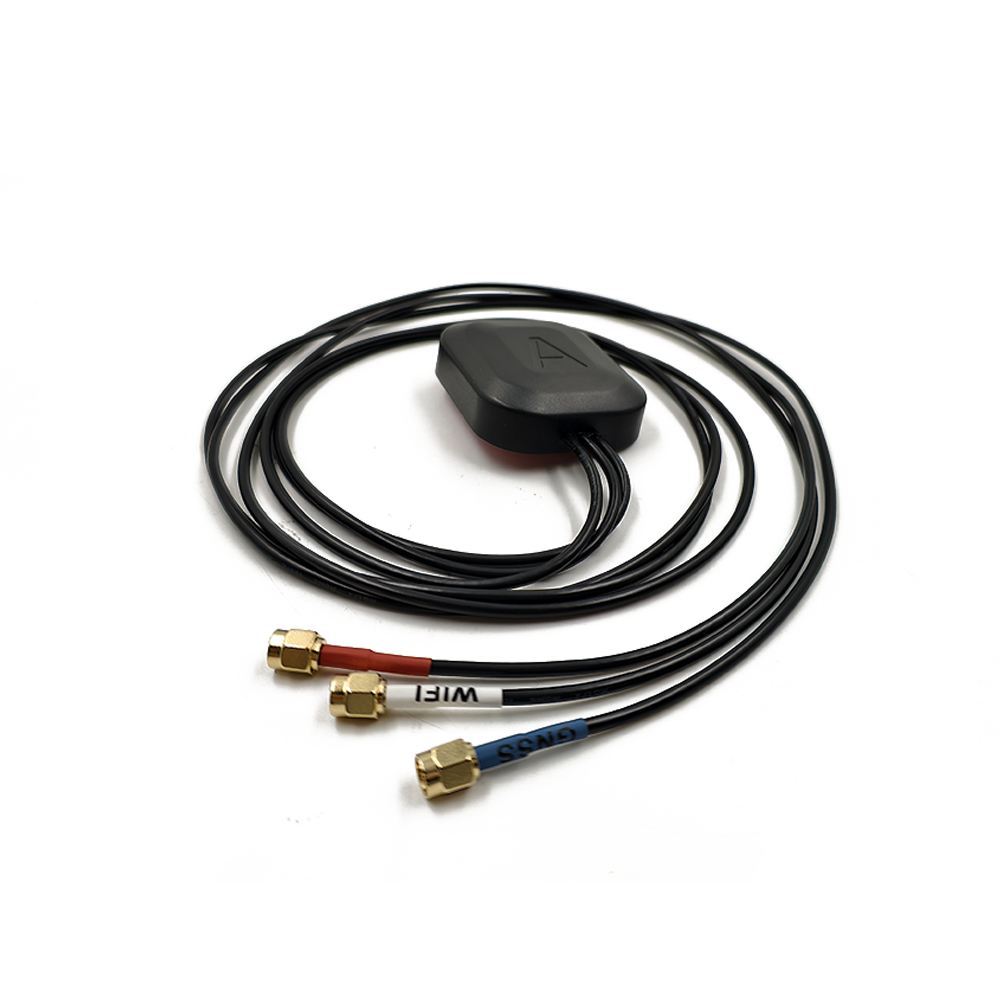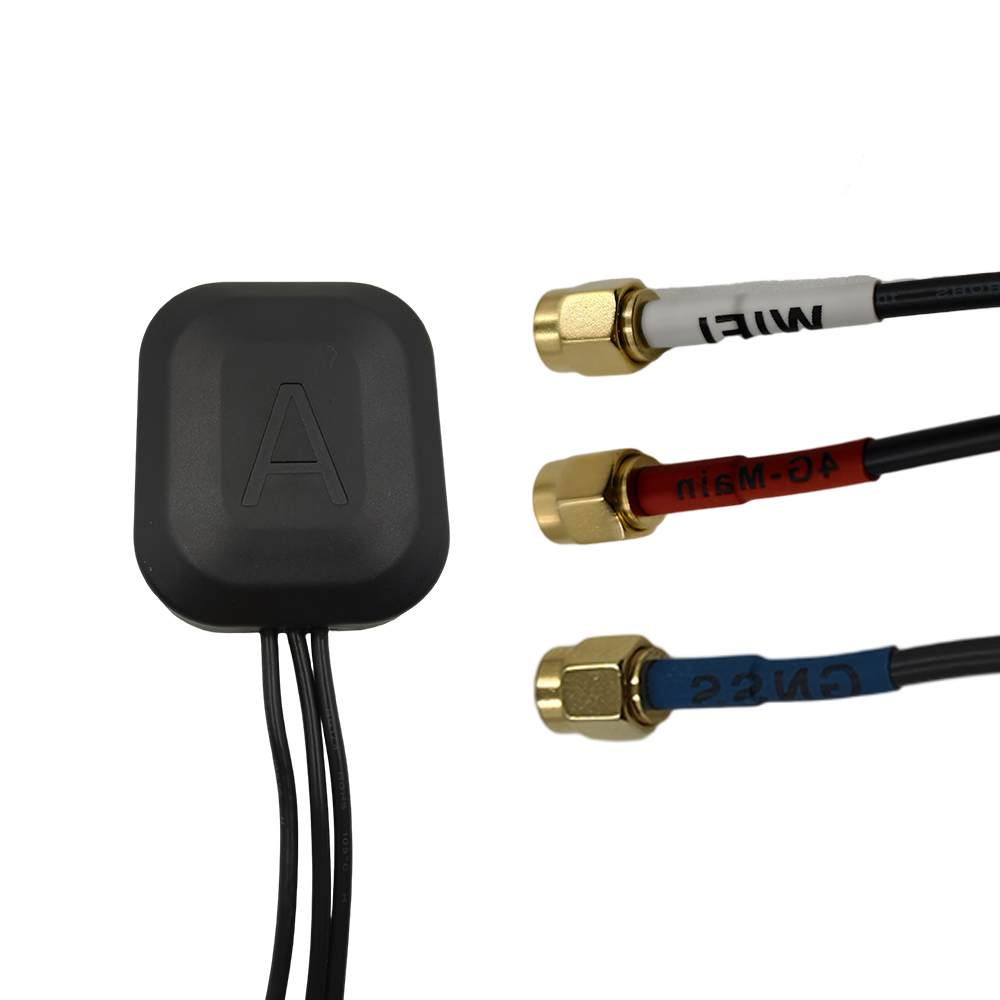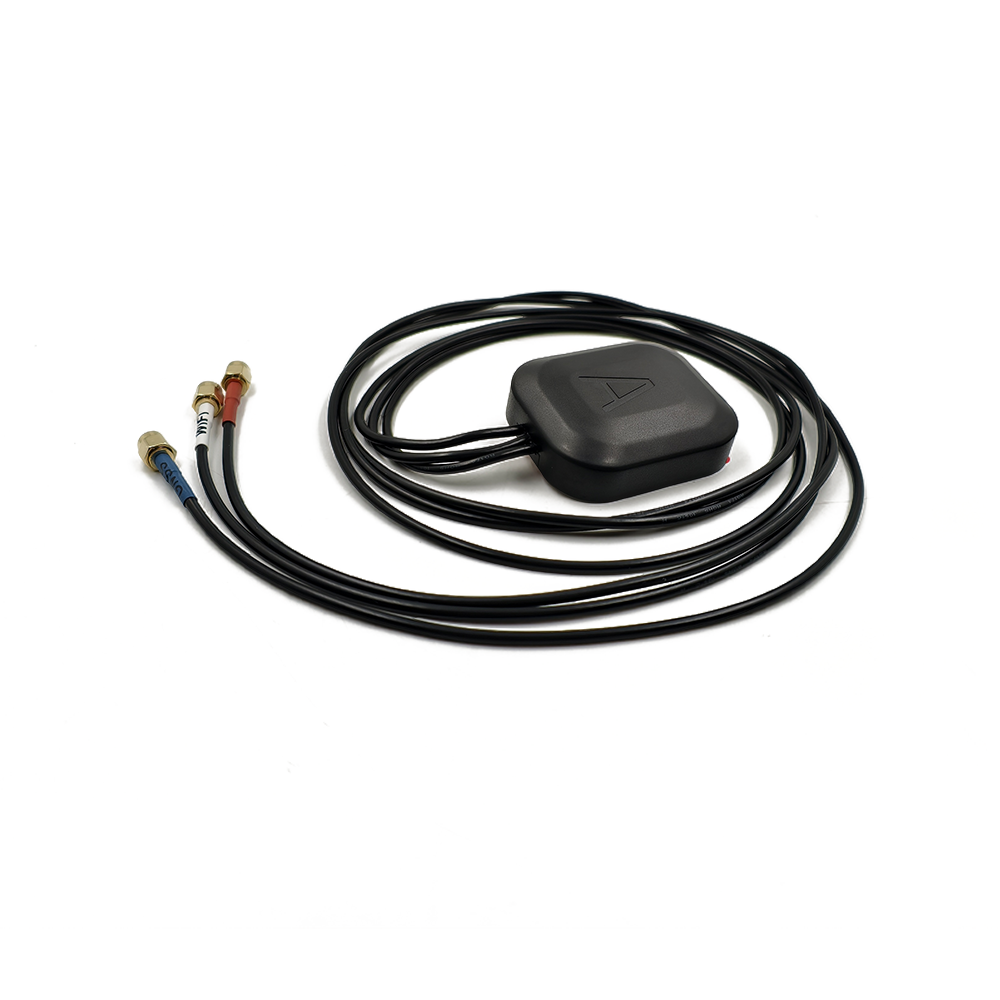Multi-band RTK Ceramic Antenna’s functionality
At the core of the Multi-band RTK Ceramic Antenna’s functionality is its active design, which incorporates low-noise amplifiers (LNAs) to boost weak signals across its operating bands. Unlike passive antennas that rely solely on their physical structure for signal capture, active antennas like this one use internal amplification to enhance the strength of GNSS, 4G LTE, and WIFI/BT signals, ensuring robust performance even in challenging environments such as urban canyons, dense foliage, or remote areas with limited infrastructure. This active amplification is particularly critical for RTK applications, where the ability to detect faint satellite signals—often attenuated by atmospheric interference or obstacles—is essential for achieving centimeter-level positioning accuracy.
The gain specification of 28 dBi underscores the antenna’s exceptional ability to amplify signals, a key factor in both navigation and communication. Gain, measured in decibels relative to an isotropic radiator (dBi), quantifies the antenna’s capacity to focus signal energy in specific directions. A high gain of 28 dBi ensures that even weak signals from GPS satellites (operating at 1575.42 MHz) or BeiDou (BD) satellites (at 1.023 MHz, likely a reference to B1 or L1 bands) are captured and amplified sufficiently for precise RTK calculations. For 4G LTE, this gain extends the range of cellular towers operating in the 824~960 MHz (low band) and 1710~2690 MHz (mid to high band) ranges, enabling reliable data transmission for applications like real-time vehicle tracking, over-the-air updates, and video streaming. In WIFI/BT bands, the high gain enhances wireless coverage, supporting seamless connectivity between devices in smart vehicles or industrial setups.
The impedance of 50 ohms is a standard specification in RF (Radio Frequency) systems, ensuring optimal power transfer between the antenna and connected devices such as RTK receivers, 4G modems, or WIFI routers. Impedance matching is critical for minimizing signal reflections, which can degrade performance by causing interference or reducing signal strength. By adhering to the 50-ohm standard, the antenna integrates seamlessly with most commercial and industrial equipment, eliminating the need for additional matching components and simplifying system design. This compatibility is particularly valuable in multi-band systems, where mismatched impedance across different frequencies could lead to cross-interference and reduced efficiency.
The standing wave ratio (VSWR) specifications—though seemingly unusual at first glance—provide insights into the antenna’s efficiency across its bands. For GNSS (active), the listed VSWR of 283 is likely a typo, with the intended value almost certainly ≤2.0, a common standard for high-performance GNSS antennas. A low VSWR indicates efficient power transfer, with minimal signal reflection. For LTE, the “average -2” and WIFI/BT “-2” are also likely typos, with typical values for these bands ranging from 1.5 to 2.0. Assuming corrected values, the antenna maintains efficient operation across all bands, ensuring that most of the signal is transmitted or received rather than reflected, which is crucial for maintaining the integrity of both RTK positioning data and 4G/WIFI communications.
The axial ratio—a critical parameter for GNSS performance—is specified as ≤4 for GNSS, with GSM, WIFI, and BT marked as NA (Not Applicable). Axial ratio measures the purity of circular polarization, with lower values indicating more perfect circular polarization. GNSS satellites transmit signals using right-hand circular polarization (RHCP), and an axial ratio of ≤4 ensures that the antenna efficiently captures these signals, minimizing loss due to polarization mismatch. This is particularly important for RTK applications, where even minor signal losses can translate into positioning errors. For LTE and WIFI/BT, which use linear polarization, axial ratio is irrelevant, hence the NA designation.
The interface types—FAKRA and SMA, with customization options— enhance the antenna’s versatility across industries. FAKRA connectors are widely used in automotive applications, featuring color-coding to prevent incorrect connections between different signal types (e.g., GPS, LTE, WIFI) and ensuring secure, vibration-resistant mounting—essential for vehicle environments. SMA connectors, on the other hand, are standard in industrial and consumer electronics, offering a robust, threaded design that ensures reliable connections in harsh conditions. Customization options allow manufacturers to adapt the antenna to specific hardware requirements, making it suitable for everything from compact IoT devices to large industrial machinery.
The frequency bands
The frequency bands covered by the antenna are carefully selected to support its multi-functional capabilities. For GNSS, it operates at 1575.42 MHz (GPS L1) and 1.023 MHz (likely a reference to BeiDou B1 or GPS L1, with a possible decimal placement error), ensuring compatibility with major satellite constellations. This enables precise RTK positioning by leveraging signals from multiple satellites, reducing the impact of signal blockages or atmospheric interference. For 4G LTE, the antenna covers 824~960 MHz (low band) and 1710~2690 MHz (mid to high band), supporting global cellular networks. The low band offers superior penetration through obstacles, making it ideal for urban or rural areas, while the mid to high band enables high-speed data transfer, critical for applications like real-time video streaming or large data uploads. While WIFI/BT frequencies are not explicitly listed, they typically include 2.4 GHz (2400~2500 MHz) for WIFI 4 and Bluetooth, enabling short-range wireless connectivity.
Polarization types are tailored to each band: RHCP for GNSS, and linear polarization (LP) for LTE and WIFI/BT. RHCP ensures optimal alignment with GNSS satellite signals, maximizing signal capture and reducing errors caused by reflections or atmospheric effects. Linear polarization, on the other hand, matches the polarization of cellular towers and WIFI routers, ensuring efficient signal transfer for terrestrial communications. This polarization diversity allows the antenna to excel in both satellite and terrestrial connectivity, a key advantage for multi-functional systems.
The temperature ranges for storage and operation—-40~+85°C—highlight the antenna’s durability in extreme environments. This wide range ensures reliable performance in Arctic cold, desert heat, or industrial settings with fluctuating temperatures. The ceramic core and internal components are designed to withstand thermal expansion and contraction, maintaining electrical stability across the temperature spectrum. For example, in subzero conditions, the ceramic material resists brittleness, while in high heat, it avoids degradation that could alter the antenna’s phase center or reduce gain. This resilience makes the antenna suitable for year-round, all-weather operations in remote or harsh locations.
The ceramic-based design is a defining feature that contributes to the antenna’s precision and performance. Ceramic materials—typically barium titanate or similar compounds—exhibit high dielectric constants, allowing for compact antenna designs without sacrificing signal reception. The ceramic element acts as a resonator, efficiently capturing and focusing GNSS signals, which is critical for RTK accuracy. Unlike metal-based antennas, ceramic antennas offer better resistance to electromagnetic interference (EMI), a common issue in multi-band systems where 4G or WIFI signals could disrupt GNSS reception. The ceramic housing also provides physical protection, shielding internal components from moisture, dust, and impact—essential for long-term reliability in outdoor applications.
operational principles
In terms of operational principles, the Multi-band RTK Ceramic Antenna works by simultaneously capturing signals from GNSS satellites, 4G cellular towers, and WIFI/BT devices. The active LNAs amplify these signals before passing them to respective receivers: an RTK receiver for positioning data, a 4G modem for cellular communication, and a WIFI/BT chip for local connectivity. The RTK receiver uses carrier-phase measurements from GNSS signals to calculate centimeter-level position, while 4G and WIFI/BT enable real-time data transmission, allowing for remote monitoring, control, and data analysis. This integration of positioning and communication makes the antenna a hub for smart systems that require both location awareness and connectivity.
One of the key advantages of the Multi-band RTK Ceramic Antenna is its seamless integration of high-precision positioning and communication. In autonomous vehicles, for example, it provides RTK-level accuracy for navigation while using 4G to transmit sensor data to cloud platforms and WIFI/BT to connect with in-vehicle systems. This integration eliminates the need for separate antennas, reducing complexity, weight, and installation costs. Similarly, in precision agriculture, the antenna enables tractors to navigate fields with centimeter accuracy while using 4G to upload yield data or receive weather updates, optimizing farming operations.
Another significant benefit is its resilience to signal disruptions. The multi-band design ensures that if one frequency band is congested or blocked, the antenna can switch to another. For instance, if GPS signals are disrupted in an urban canyon, the antenna can rely on BeiDou signals for positioning, while 4G can switch to a different band if the current one is congested. This redundancy is critical for safety-critical applications like emergency services or autonomous driving, where uninterrupted operation is essential.
The antenna’s compact size and ceramic construction also offer advantages in terms of design flexibility. Ceramic antennas are smaller and lighter than traditional metal antennas, making them suitable for integration into compact devices such as drones, wearable trackers, or portable surveying equipment. The ceramic material’s low profile allows for discreet installation, whether on the roof of a vehicle, the hull of a boat, or the frame of a drone, without compromising aerodynamics or aesthetics.
The Multi-band RTK Ceramic Antenna finds applications across a diverse range of industries, each leveraging its unique capabilities. In autonomous transportation, including self-driving cars, trucks, and drones, it provides the centimeter-level positioning required for safe navigation, while 4G and WIFI enable communication with control centers and other vehicles (V2X communication). This ensures that autonomous systems can make real-time decisions based on accurate location data and up-to-date information about their surroundings.
In precision agriculture
-
In precision agriculture, the antenna is integrated into GPS-guided tractors, harvesters, and drones. It allows farmers to map fields, apply fertilizers, and harvest crops with unprecedented accuracy, reducing waste and improving yields. The 4G connectivity enables real-time monitoring of equipment and crop conditions, while WIFI facilitates communication between on-site devices, such as soil sensors and irrigation systems.
Smart city infrastructure benefits from the antenna’s ability to support both positioning and communication. It is used in smart traffic management systems to track vehicles and optimize traffic flow, in waste management to monitor bin levels and route collection trucks, and in public safety to track emergency response vehicles with precision. The multi-band support ensures reliable operation even in dense urban environments, where buildings and electromagnetic interference can disrupt signals.
In industrial IoT (IIoT), the antenna enables precise tracking of assets such as containers, machinery, and tools in large facilities like factories or ports. RTK positioning ensures that assets can be located with centimeter accuracy, while 4G and WIFI facilitate data transmission for inventory management, predictive maintenance, and process optimization. The antenna’s durability in extreme temperatures makes it suitable for industrial environments with harsh conditions.
Marine and aerospace applications also leverage the antenna’s capabilities. In marine navigation, it provides accurate positioning for ships and offshore platforms, ensuring safe passage and efficient route planning, while 4G enables communication with shore-based facilities. In aerospace, it is used in drones and small aircraft for precise mapping, inspection, and navigation, with WIFI/BT supporting communication between the aircraft and ground control.
Despite its many strengths, the Multi-band RTK Ceramic Antenna has considerations for users. Its active design requires a power source to operate the LNAs, which may be a concern for battery-powered devices with strict energy constraints. However, advancements in low-power amplifier technology have minimized power consumption, making it suitable for most applications. Additionally, the antenna’s performance is dependent on the quality of the connected receivers and the availability of RTK correction data, which is typically provided by a base station or a network of stations. Users must ensure that this infrastructure is in place to achieve centimeter-level accuracy.
In conclusion
-
In conclusion, the Multi-band RTK Ceramic Antenna represents a significant advancement in integrated positioning and communication technology, combining the precision of RTK GNSS with the connectivity of 4G and WIFI/BT in a compact, durable package. Its active design, multi-band support, and ceramic construction enable reliable performance in diverse environments, from urban cities to remote rural areas. Whether in autonomous vehicles, precision agriculture, smart cities, or industrial IoT, this antenna plays a pivotal role in enabling the next generation of high-precision, connected systems. As technology continues to evolve, the Multi-band RTK Ceramic Antenna will remain a key enabler, driving innovation in industries where accuracy, reliability, and connectivity are paramount. Its ability to seamlessly integrate multiple functions into a single, efficient component makes it an indispensable tool in the modern technological landscape.




































































 Language
Language
 En
En Cn
Cn Korean
Korean

 Home >
Home > 








 18665803017 (Macro)
18665803017 (Macro)













